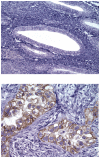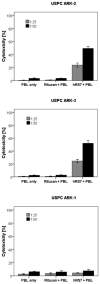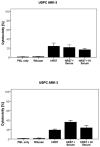Uterine serous papillary carcinomas overexpress human trophoblast-cell-surface marker (Trop-2) and are highly sensitive to immunotherapy with hRS7, a humanized anti-Trop-2 monoclonal antibody
- PMID: 21246534
- PMCID: PMC3128671
- DOI: 10.1002/cncr.25891
Uterine serous papillary carcinomas overexpress human trophoblast-cell-surface marker (Trop-2) and are highly sensitive to immunotherapy with hRS7, a humanized anti-Trop-2 monoclonal antibody
Abstract
Background: Uterine serous papillary carcinoma (USPC) was an aggressive and chemotherapy resistant variant of endometrial cancer. The authors evaluated the expression of human trophoblast-cell-surface-marker (Trop-2) and the potential of hRS7, a humanized anti-Trop-2 monoclonal antibody, as a novel therapeutic strategy against USPC.
Methods: Trop-2 expression was evaluated by immunohistochemistry (IHC) in a total of 23 USPC. Six primary USPC cell lines were assessed by flow cytometry and real-time polymerase chain reaction (PCR) for Trop-2 expression. Sensitivity to hRS7 (Immunomedics, Inc.) antibody-dependent cellular cytotoxicity (ADCC) and complement-dependent cytotoxicity was tested in standard 5-hour ⁵¹Cr-release assays against primary USPC cell lines.
Results: Expression of Trop-2 was found in 15 of 23 (65%) of the tumor tissues tested by IHC and in 50% (3 of 6) of the USPC cell lines tested by real-time PCR and flow-cytometry (Trop-2 expression in USPC versus normal endometrial cells; P < .005). USPC cell lines overexpressing Trop-2, regardless of their intrinsic resistance to natural killer cytotoxicity, were highly sensitive to hRS7-mediated ADCC in vitro (range of killing, 28.2% to 64.4%) (P < .001). Negligible cytotoxicity against USPC was seen in the absence of hRS7 or in the presence of rituximab control antibody (range of killing, 1.1% to 12.4%). Incubation with interleukin-2 (50 IU/mL) in addition to hRS7 further increased the cytotoxic activity against USPC cell lines overexpressing Trop-2 (P = .008).
Conclusions: Trop-2 was highly expressed in uterine serous carcinoma at mRNA and protein levels. Primary USPC cell lines are highly sensitivity to hRS7-mediated cytotoxicity in vitro. hRS7 may represent a novel therapeutic agent for USPC refractory to standard treatment modalities.
Copyright © 2011 American Cancer Society.
Figures





Similar articles
-
Cervical carcinomas overexpress human trophoblast cell-surface marker (Trop-2) and are highly sensitive to immunotherapy with hRS7, a humanized monoclonal anti-Trop-2 antibody.Am J Obstet Gynecol. 2011 Dec;205(6):567.e1-7. doi: 10.1016/j.ajog.2011.06.093. Epub 2011 Jul 13. Am J Obstet Gynecol. 2011. PMID: 21889762 Free PMC article.
-
High-grade, chemotherapy-resistant primary ovarian carcinoma cell lines overexpress human trophoblast cell-surface marker (Trop-2) and are highly sensitive to immunotherapy with hRS7, a humanized monoclonal anti-Trop-2 antibody.Gynecol Oncol. 2011 Jul;122(1):171-7. doi: 10.1016/j.ygyno.2011.03.002. Epub 2011 Mar 30. Gynecol Oncol. 2011. PMID: 21453957 Free PMC article.
-
Overexpression of EpCAM in uterine serous papillary carcinoma: implications for EpCAM-specific immunotherapy with human monoclonal antibody adecatumumab (MT201).Mol Cancer Ther. 2010 Jan;9(1):57-66. doi: 10.1158/1535-7163.MCT-09-0675. Epub 2010 Jan 6. Mol Cancer Ther. 2010. PMID: 20053761 Free PMC article.
-
Advances in Trop-2 targeted antibody-drug conjugates for breast cancer: mechanisms, clinical applications, and future directions.Front Immunol. 2024 Nov 1;15:1495675. doi: 10.3389/fimmu.2024.1495675. eCollection 2024. Front Immunol. 2024. PMID: 39555080 Free PMC article. Review.
-
The Mode of Action and Clinical Outcomes of Sacituzumab Govitecan in Solid Tumors.Clin Cancer Res. 2025 Apr 14;31(8):1390-1399. doi: 10.1158/1078-0432.CCR-24-1525. Clin Cancer Res. 2025. PMID: 39903492 Free PMC article. Review.
Cited by
-
Trop-2 protein overexpression is an independent marker for predicting disease recurrence in endometrioid endometrial carcinoma.BMC Clin Pathol. 2012 Nov 14;12:22. doi: 10.1186/1472-6890-12-22. BMC Clin Pathol. 2012. PMID: 23151048 Free PMC article.
-
Emerging therapeutic biomarkers in endometrial cancer.Biomed Res Int. 2013;2013:130362. doi: 10.1155/2013/130362. Epub 2013 Jun 11. Biomed Res Int. 2013. PMID: 23819113 Free PMC article. Review.
-
Chemotherapy agents-induced immunoresistance in lung cancer cells could be reversed by trop-2 inhibition in vitro and in vivo by interaction with MAPK signaling pathway.Cancer Biol Ther. 2013 Dec;14(12):1123-32. doi: 10.4161/cbt.26341. Epub 2013 Sep 4. Cancer Biol Ther. 2013. PMID: 24025415 Free PMC article.
-
Establishing a comprehensive panel of patient-derived xenograft models for high-grade endometrial carcinoma: molecular subtypes, genetic alterations, and therapeutic target profiling.Neoplasia. 2025 Jun;64:101158. doi: 10.1016/j.neo.2025.101158. Epub 2025 Apr 7. Neoplasia. 2025. PMID: 40199194 Free PMC article.
-
Cervical carcinomas overexpress human trophoblast cell-surface marker (Trop-2) and are highly sensitive to immunotherapy with hRS7, a humanized monoclonal anti-Trop-2 antibody.Am J Obstet Gynecol. 2011 Dec;205(6):567.e1-7. doi: 10.1016/j.ajog.2011.06.093. Epub 2011 Jul 13. Am J Obstet Gynecol. 2011. PMID: 21889762 Free PMC article.
References
-
- Jemal A, Siegel R, Xu J, Ward E. Cancer statistics, 2010. CA Cancer J Clin. 2010;60:277–300. - PubMed
-
- Hendrickson M, Ross J, Eifel P, Martinez A, Kempson R. Uterine papillary serous carcinoma: a highly malignant form of endometrial adenocarcinoma. Am J Surg Pathol. 1982;6:93–108. - PubMed
-
- Creasman W, Kohler M, Odicino F, et al. Prognosis of papillary serous, clear cell, and Grade 3 Stage I carcinoma of the endometrium. Gynecol Oncol. 2004;95:593–596. - PubMed
-
- Schwartz PE. The management of serous papillary uterine cancer. Curr Opin Oncol. 2006;18(5):494–9. Schwartz PE. - PubMed
-
- Carcangiu ML, Chambers JT. Uterine papillary serous carcinoma: a study on 108 cases with emphasis on prognostic significance of associated endometrioid carcinoma, absence of invasion, and concomitant ovarian cancer. Gynecol Oncol. 1992;47:298–305. - PubMed
Publication types
MeSH terms
Substances
Grants and funding
LinkOut - more resources
Full Text Sources
Other Literature Sources
Medical
Research Materials
Miscellaneous

